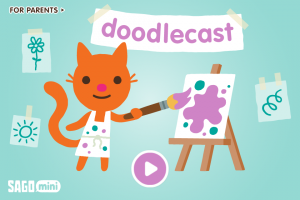
A few months ago I was at a Starbucks and picked up one of those cards to get a free app download. The app seemed to be some sort of child’s drawing tool, and since my daughter already loves DoodleBuddy, I thought, hey, it’s free, why not. Sure enough, my 4-year-old (excuse me, she’s “four and a half,” as she’d correct me) loved Sago Mini Doodlecast from the start. As I listened to/watched her explore the app, it occurred to me what a brilliant tool it was for digital storytelling in the world language classroom. In fact, it’s my new favorite app for digital storytelling. It’ll cost you $2.99, but it’s worth it. It has everything you could want in such an app: lots of options for visuals, various language interfaces, and most importantly, audio recording.
To start, from a parent’s perspective, I really appreciate that to enter the “For Parents” section of the app, you have to follow directions to touch the screen a certain way. With my little one it’s been an effective parent control.
Within your app settings on your iOS device, you can change several settings, including turning the parental control on or off, limiting videos to 10 minutes (Zoe takes so long to tell a story she’d fill up her iPod in a few stories) and limit the gallery to 20 items (the app will delete the oldest video after 20).
Also, you can change the app’s interface language. And I mean REALLY change the language. Like to Suomi. (Yeah, that’s Finnish for… Finnish.)
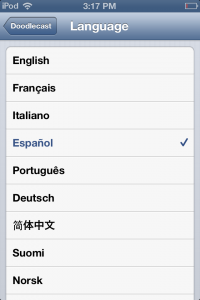
Back to the app. If you’re feeling creative, just start with a blank page and draw. While you draw, the app records your narration and shows you how long your video will be.
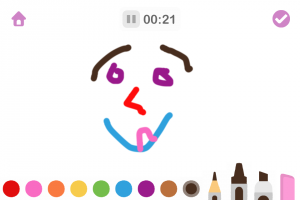
If you’re not feeling so creative, you can draw from one of several prompts that the app offers. What’s in the grocery cart? What’s something that’s big? What’s something that’s loud? Zoe likes these best.
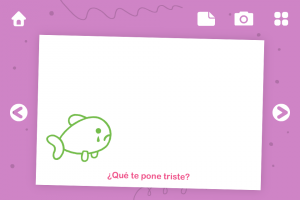
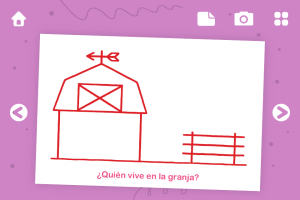
Or, make your own “prompt”: snap a photo and draw/narrate a story from there. I did one using a photo of the Champ the Lion Stuffie my toddler got for Christmas.
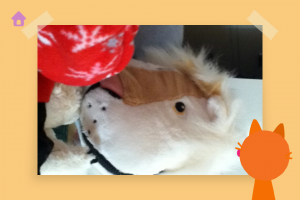
When you’re done, play back the video from the app. At the end, the little cat claps for you (Zoe thinks this is cool).
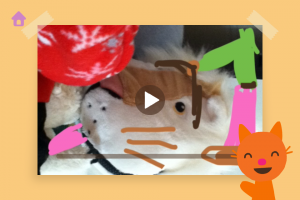
If you want to share your video (or your students share with you), save the story to your video gallery and then upload to YouTube. (The video usually ends up too large to email.)
Zoe’s in that bilingual kid stage where she really prefers to speak English and I have to cajole her to speak Spanish, but she graciously recorded a story for you to illustrate that this thing is so easy a preschooler can do it.
7 Comments
Comments are closed.
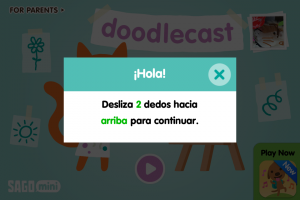
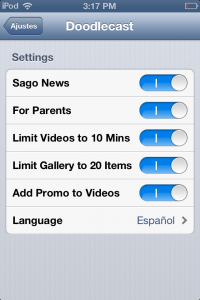




Looks cool! Am wondering if for $2 more one should get the Doodlecast Pro for more uses in the classroom??
Let me know how it is if you try it!
First of all, let me say that I’m so impressed with your daughter’s Spanish! How did you do it? I am trying to figure out where to begin with my children…I should have been speaking Spanish to them all along I know. Any advice?
As for the app, it looks like it could be useful and fun. My school district’s technology is…well, lacking -but I will probably write a grant for iPads next year, so this is something I will keep in mind. In the meanwhile, I will use it at home with my own kiddos. Thanks for the always inspiring posts!
Thank you! I didn’t do anything special- I have spoken mostly in Spanish to my children since they were born, and that’s just how it happens. I do have to insist a lot for Zoe to speak Spanish now she’s been in English preschool so long. But she can.
How old are your children? For young children, the video series from Whistlefritz is very good. For very young children, the videos from A la víbora de la mar are very good but I don’t think they’re available in the States anymore. 🙁
If you’re interested in an actual curriculum, Calico Spanish is about to release a homeschool curriculum that’s absolutely unmatched. I’m REALLY biased because I’m the primary author on it (LOL) but seriously, Erica Fischer has put together a team that has developed a product based on storytelling and ACTFL standards & I Can statements, engaging and supplemented by videos, with lots of ideas targeted at children ages 5-12ish learning at home. The first level is almost ready. You can contact her through the website to find out more if you’re interested.
Good luck! The bilingual children journey is a joy!!
[…] frames in Spanish if she can come up with the vocabulary (you can hear her tell you a little story here). All three of them (now ages almost 6, almost 3, and almost 2) understand me perfectly when I […]
[…] frames in Spanish if she can come up with the vocabulary (you can hear her tell you a little story here). All three of them (now ages almost 6, almost 3, and almost 2) understand me perfectly when I […]
[…] married, and had some kids and a crazy bilingual family journey (listen to my daughter at 4 1/2 tell a story with DoodleCast), and then my father […]